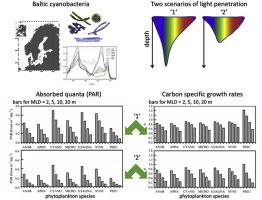Estuarine, Coastal and Shelf Science ( IF 2.6 ) Pub Date : 2020-05-23 , DOI: 10.1016/j.ecss.2020.106853 Malgorzata Stramska , Joanna Stoń-Egiert , Miroslawa Ostrowska

|
Potential influences of various environmental factors (light conditions, mixed layer depth, water temperature) on growth rates of different cyanobacteria in the Baltic Sea (BS) are discussed. Growth rates were modeled as a function of quanta absorbed by phytoplankton. This in turn depends on phytoplankton exposition to light, which we simulated to represent realistic conditions encountered in the Baltic Sea in summer. We considered eight realistic scenarios (two cases of water clarity and four depths of the mixed layer). According to our calculations, exposition of phytoplankton to photosynthetically available radiation (PAR) in the BS can change about five times in case of the same solar surface insolation and water turbidity, solely due to changes in the mixed layer depth from 2 to 20 m. When we additionally accounted for differences in water turbidity, phytoplankton PAR exposition changed by one order of magnitude and this resulted in one order of magnitude differences in absorbed quanta for the same species of phytoplankton. Knowledge of single-species absorption characteristics allowed us to show that under the same water column conditions, the number of absorbed quanta varies significantly between different species of cyanobacteria, because of differences in their absorptive properties. The effectiveness of light absorption translated to different growth rates estimated for each phytoplankton species. Our research shows that further progress in phytoplankton modeling requires incorporating in the models improved information about optical properties, growth rates, and temperature and nutrient dependencies for different phytoplankton types.
中文翻译:

建立波罗的海蓝藻细菌生长速率的模型
讨论了各种环境因素(光照条件,混合层深度,水温)对波罗的海(BS)中不同蓝细菌生长速率的潜在影响。将生长速率建模为浮游植物吸收的量子的函数。反过来,这取决于浮游植物对光的暴露,我们对其进行了模拟,以表示夏季在波罗的海遇到的现实条件。我们考虑了八种现实情况(两种情况为水清澈,第四种深度为混合层)。根据我们的计算,在相同的太阳表面日照度和水浊度的情况下,仅由于混合层深度从2到20 m的变化,浮游植物在BS中暴露于光合作用辐射(PAR)的情况可能会变化约5倍。当我们另外考虑水浊度的差异时,浮游植物的PAR暴露变化了一个数量级,这导致同一物种的浮游植物吸收量子的数量级差异达一个数量级。对单一物种吸收特性的了解使我们能够证明,在相同的水柱条件下,不同种类的蓝细菌之间吸收的量子数量存在显着差异,这是因为它们的吸收特性不同。光吸收的有效性转化为每种浮游植物物种估计的不同增长率。我们的研究表明,浮游植物建模的进一步发展需要在模型中纳入有关光学特性,生长速率,











































 京公网安备 11010802027423号
京公网安备 11010802027423号